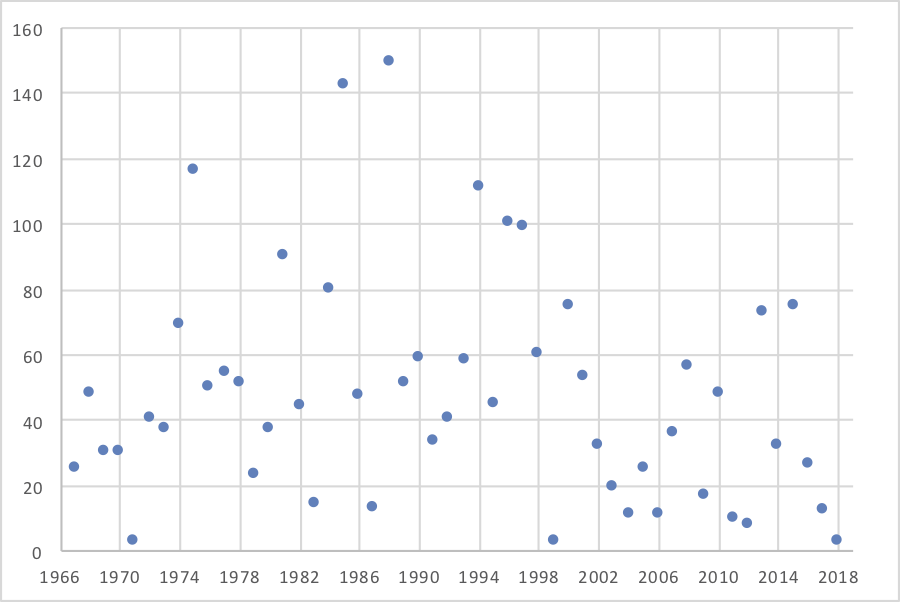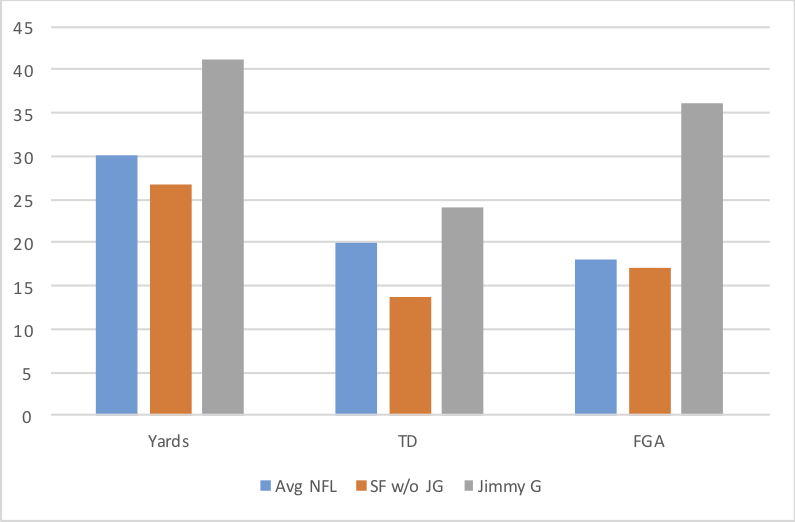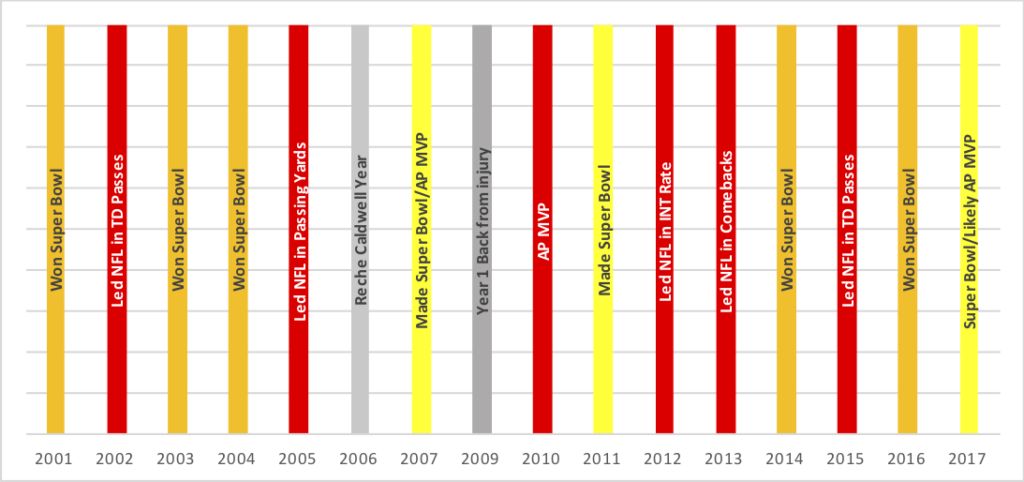Back in August, I asked you 38 questions that served as prop bets for the 2017 NFL season. Thanks to the tireless work of Jeremy De Shelter, who helped compile all the results. A couple of weeks ago, I looked at Part I. Let’s move on to Part II, beginning with the projected best and worst teams in the NFL…
Number of double digit wins by the Patriots
Number of double digit losses by the Browns
Cleveland lost 9 games by double digits in 2017, a year after losing 10 such games in 2016. It is still the 4th-most double digit losses by a Browns team since 1999. Meanwhile, New England won “only” 8 games by double digits last year, after winning 10 such games in 2016.
This was a lopsided bet in favor of the Patriots. 82% of you took the New England side, making this a big win for the minority.
Margin of victory for the Texans biggest win
Number of TD passes by the Texans TD passing leader
You might think that Deshaun Watson runs away with this if he stays healthy, as he led the team with 19 touchdown passes in 7 games. But he also led the team to a 43-point blowout of the Titans, so the margin of victory side easily won here. This was a close race, but 55% of you picked the Texans biggest win side.
Yards from scrimmage from the the leader of this group: Mike Gillislee, James White, Rex Burkhead, Dion Lewis
Yards from scrimmage from David Johnson in Arizona wins
Well, Johnson missed 15 games in 2017 due to injury, recording 91 yards from scrimmage in his lone win. The majority of you (57%) picked the Johnson side, but the Patriots side obviously won, as Lewis had 1,110 yards from scrimmage. If you knew that Lewis would lead with such a high number you might not have picked Johnson (who had less than 1,000 yards in Cardinals wins in 2016), so maybe this wasn’t just an easy win for the minority side.
Number of Receiving TDs by the player with the MOST in this group: Odell Beckham, A.J. Green, Jarvis Landry and Antonio Brown
Number of Receiving TDs combined by Pierre Garcon, Randall Cobb, and Adam Thielen
Another one of my favorite style of bets. A few months ago, you might have been shocked to learn that it was Landry (along with Brown) who led the first group in receiving touchdowns at 9 scores. On the other side, Garcon had a goose egg despite having 500 receiving yards, Cobb caught four touchdowns, and Thielen had a monster year with 1,216 yards but also had just four touchdowns. Make this question about receiving yards and it’s an easy win for the combined group, but when it comes to touchdowns, the Landry/Brown side pulled out the win.
That was an upset, as only 27% of you picked the first side.
Yards from scrimmage for Jordan Howard
Number of receiving yards by the Bears receiving yards leader, times two
Howard had 1,611 yards from scrimmage in 2016, and that dropped to 1,247 last year. The Bears had terrible receivers and finished last in the NFL in passing yards, though, which made this one of the closest races. Kendall Wright finished as Chicago’s leading receiver with 614 yards, so Group B loses this bet, 1247-1228. In the pre-season, 63% of you said that Group B would win, and I can’t blame you. But this was another upset win even with a down year from Howard.
Lowest Yards per reception by any of Tavon Austin, Danny Amendola and Larry Fitzgerald, times two
Highest Yards per reception from this group: DeSean Jackson, Kenny Stills, Martavis Bryant, Ted Ginn Jr., J.J. Nelson [No minimum]
Fitzgerald averaged 10.6 yards per reception, Amendola 10.8, and Austin 3.6! So the number to beat here was just 7.2 because of Austin. Nelson was at 17.5 all by himself, making this another win for the majority. A whopping 80% of you picked Group B, which would have been a loser if not for Austin’s 13-catch, 47-yard season. I’m not too sure how I feel about this one. The next one? That was a pretty interesting line that built in the idea of an injury that actually happened.
Number of wins by the Packers, -1.5
Number of interceptions thrown by Aaron Rodgers
From 2014-2016, Rodgers played in 48 games and averaged 7.3 interceptions per season while the Packers averaged 10.7 wins per year. So we had to subtract some wins from Green Bay to make this line interesting. Two thirds of you picked the Packers line in the preseason, thinking the 1.5-win hook wasn’t enough.
Rodgers was limited to 7 games and threw 6 interceptions. Green Bay went 7-9, which means Option A finished with 5.5 and Option B finished with 6. Score a nailbiter for the minority vote.
Lower number will be Tom Brady rank in passer rating, +1.5 [If Brady fails to throw 224 passes, this side loses]
Lower number will be Antonio Brown rank in receiving yards
Another fun line with two Hall of Famers. Brown led the NFL in receiving yards, while Brady ranked 3rd in passer rating. The lower number wins here, because Brady was the favorite. Even without the hook, Brown won this contest.
In the preseason, 63% picked the Brown side. Well done.
TDs scored (passing, rushing and receiving combined) by the player with the 4th most TDs among players in the NFC South, +4
TDs scored (passing, rushing and receiving combined) by the player with the 2nd most TDs among players from teams in California
This was as close as it got in the preseason, meaning this was a great line. The California side got 51% of the vote, with Philip Rivers or Derek Carr the likely runner up. As it turns out, Rivers had 28 TDs but he was the runner up because Jared Goff scored 29 (28 passing, 1 rushing); Carr finished with 22. In the NFC South, the question here was whether all four QBs would have big good enough years to win this with the 4 TD edge. Cam Newton had 28 TDs, Drew Brees had 25, and Matt Ryan and Jameis Winston each had 20. If Goff didn’t have a breakout season, the NFC South wins because of the +4 TD edge. Score one for California over the NFC South.
Games started by rookie quarterbacks, +0.5
Games started by QBs who will be 38 years old during this season (i.e., Brees, Palmer, McCown)
I loved this line in the pre-season. Brees had 16 starts, McCown 13, and Palmer 7, combining for 36 starts. But the rookies did well, at least when it came to starts: DeShone Kizer started 15 games, Mitch Trubisky started 12, and Deshaun Watson 6. That combines for 33 starts, which allowed C.J. Beathard (5) and Nathan Peterman (2) put the rookies over the edge. In the preseason, 76% of you picked the 38-year old quarterbacks, likely not counting on Kizer to start 15 games.
And the last one of the day…
Number of rushing TDs by the QB with the most rushing touchdowns
Number of 100-yard rushing games by Ezekiel Elliott, +0.5
Elliott had 5 games with 100 rushing yards, and the tiebreaker goes to Elliott. But alas, Cam rushed for 6 touchdowns, giving Option A the win. In the preseason, 59% of you picked the rushing TD side, knowing there was a chance that an Elliott suspension would tip the scales.
What stands out to you?








